The Apple iPhone 6s and iPhone 6s Plus Review
by Ryan Smith & Joshua Ho on November 2, 2015 8:00 AM EST- Posted in
- Smartphones
- Apple
- Mobile
- SoCs
- iPhone 6s
- iPhone 6s Plus
Display
In pretty much any smartphone, displays are going to be one of the most important aspects of the user experience. If a display is dim or has a highly reflective display it will be unreadable outdoors. If the contrast is low, the display can become difficult to read and not particularly appealing to the eye. Other issues like lack of color stability and contrast stability with changes in viewing angles will be much more noticeable than on something like a laptop or desktop where the monitor is usually kept at a constant position in space relative to the eye. In order to evaluate these factors we use both relative comparisons and absolute measurements. Although the human eye is sufficient for relative comparison, for absolute measurements we use X-Rite’s i1Pro2 spectrophotometer for precise color and luminance measurements, along with X-Rite’s i1Display Pro colorimeter for accurate contrast figures. Hardware alone is insufficient for collecting and presenting data, so we also use SpectraCal’s CalMAN 5 with a custom workflow, which allows for collecting and presenting data in a readable manner.
In the case of the iPhone 6s and iPhone 6s Plus, the display appears to be effectively unchanged from the iPhone 6 and iPhone 6 Plus. The iPhone 6s retains the 1334x750 resolution of the previous variant, and the iPhone 6s Plus has the same 1080p resolution as well. Apple continues to use the same M2 scaler as well, which means that although the display’s physical resolution is 1080p Apple is actually rendering the display at 2208x1242 and scaling it to fit the display. The resolution of the iPhone 6s is on the low side relative to most Android devices, which is noticeable but the pixel density is sufficient to avoid any obvious problems here.
As with the iPhone 6, both the iPhone 6s and 6s Plus use dual domain pixels, which make the subpixels look more like chevrons under a microscope. This improves viewing angles by reducing the amount of color shifting that occurs when the display viewing angle is changed. As far as I can tell, Apple continues to be one of the few OEMs that pulls this off effectively. Although contrast and luminance aren’t perfectly consistent with changes in viewing angles, it basically looks like the display is painted underneath the glass. The iPhone 6s Plus does a better job at pulling off this illusion as the higher pixel density helps to eliminate some of the fuzziness or pixilation that might otherwise occur. Samsung gets close here, but for whatever reason ambient light causes noticeable interference effects and in general there’s noticeable color shift when moving the display around. Weirdly enough, the OEM that seems to be doing the best job here continues to be HTC with the One M9+.

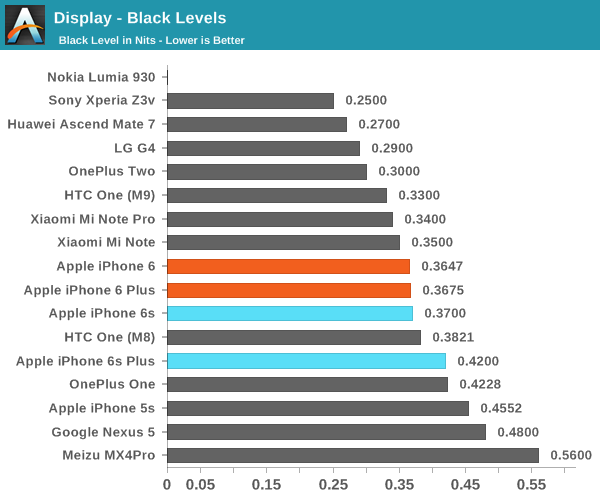
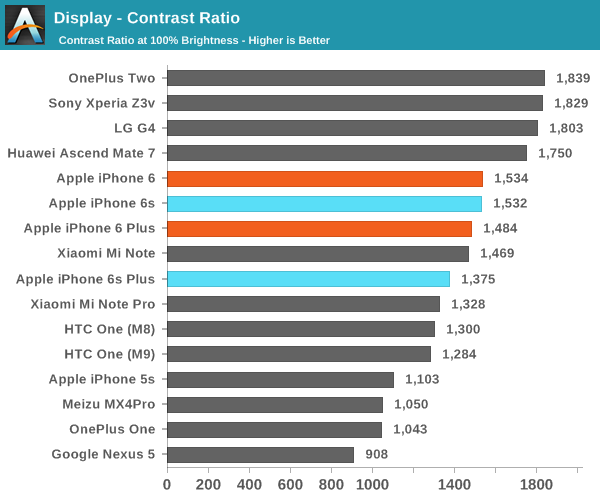
Moving on to our usual brightness and contrast testing, it looks like Apple has improved the maximum brightness of their displays with the use of the new LED backlight driver, but it’s important to note that in the case of the iPhone 6s, the maximum brightness isn’t constant. The behavior is relatively subtle, but with iOS 9 at maximum brightness the display brightness steadily lowers over the course of an hour by about 10 nits maximum. It looks like this effect tails off in both the rate of luminance decrease and overall luminance decrease as peak brightness approaches 500 nits, where the effect appears to be non-existent. It’s likely that this behavior is designed to reduce the battery impact of keeping the display at maximum brightness in all situations. Either way, peak luminance is high enough that it isn’t a struggle to read the display outdoors and contrast in low-light conditions also remains high due to the use of photo-alignment in the liquid crystal layer which helps to make the liquid crystals stay in the right shape.
iPhone 6s
iPhone 6s Plus

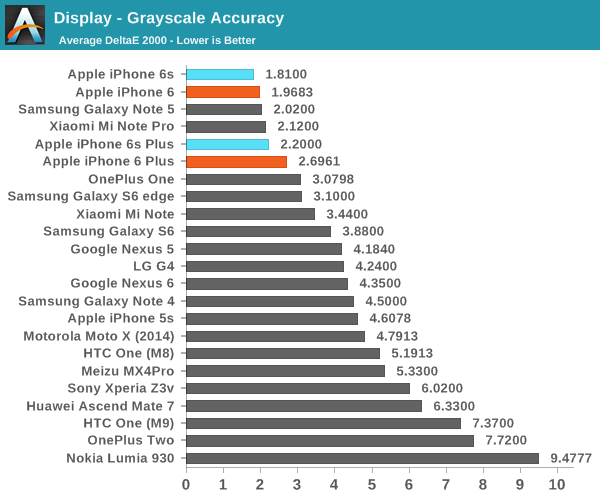
In grayscale, we don’t quite see the near-perfect white balance we saw last year but gamma remains almost impeccable when compared to the industry standard power 2.2 gamma. I suspect that the units we received this time are closer to the mean for white balance compared to last year, as in general due to the blue LED backlights used in most LCDs a colder color balance will generally require less power to display than a warmer one.
iPhone 6s
iPhone 6s Plus

In our saturation sweep testing, the iPhone 6s and 6s Plus both continue to track closely to expected values for sRGB, which is the current industry standard color gamut. I don’t really have any criticism here. The previous iPhone’s displays were of similar caliber, so this is pretty much par for the course if you’re used to iPhone displays.
iPhone 6s
iPhone 6s Plus
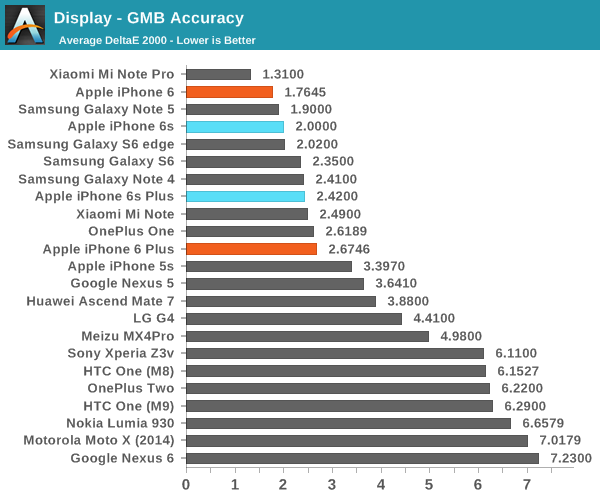
Similarly in the GMB ColorChecker, the iPhone 6s and 6s Plus both pass with flying colors. If you’re using an iPhone 6s or 6s Plus for any remotely color-critical work like viewing and/or editing photos and videos, it’s a pretty fair bet that you’ll be able to rely on these phones to provide an accurate color reproduction in pretty much any condition. Samsung does provide better contrast and the possibility of extra color saturation with their Galaxy S6 and Note 5, but this comes at the cost of potential for burn-in, increased power consumption in certain scenarios, and increased distortion with changes in viewing angles. I think this means that it basically comes out to a wash, but depending upon personal taste one may prove to be better than another.



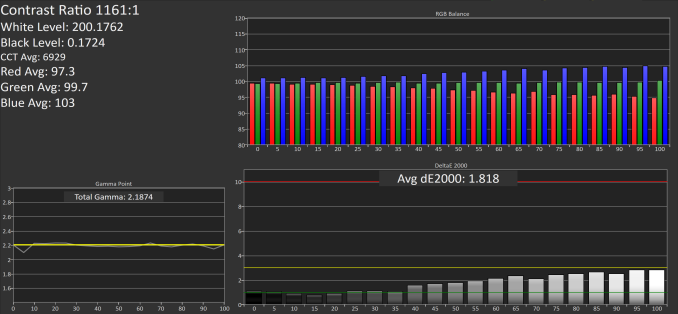
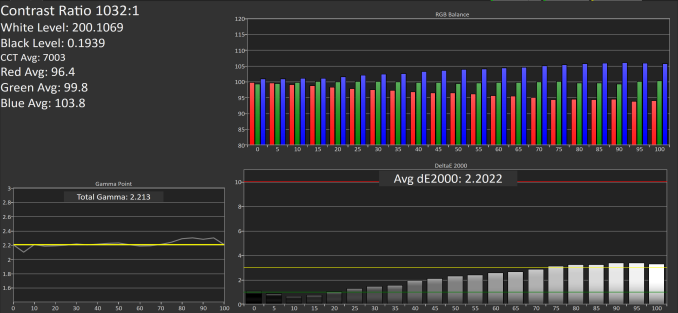
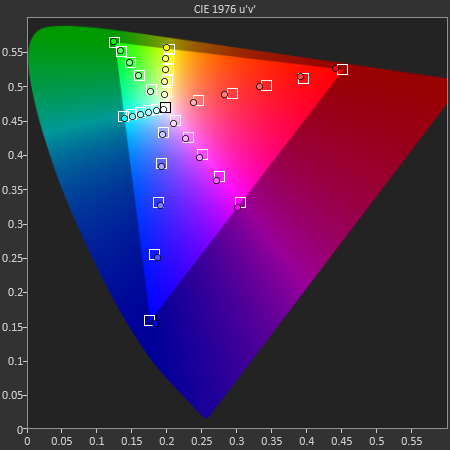
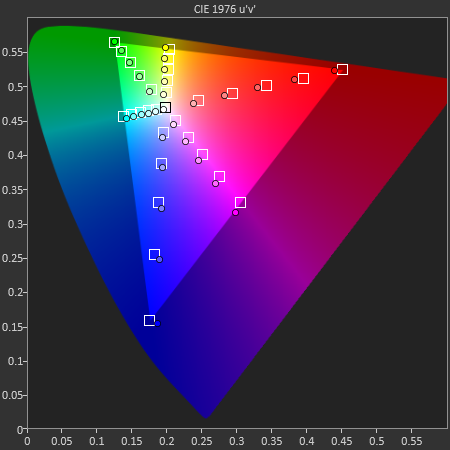
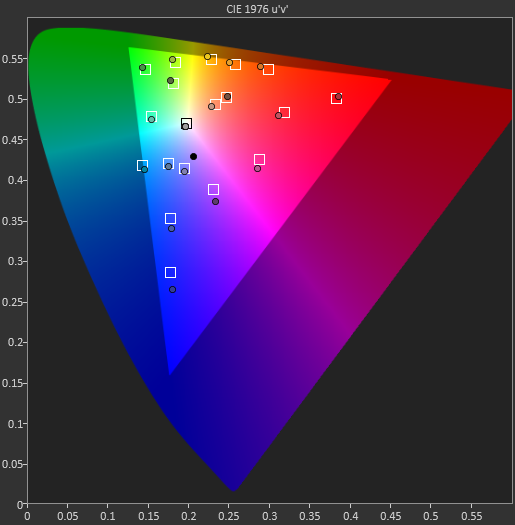
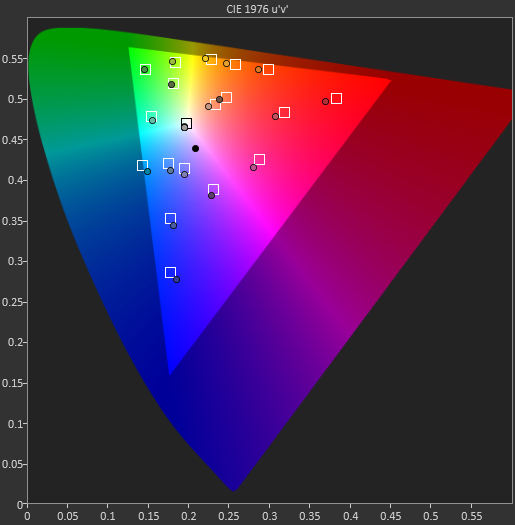








531 Comments
View All Comments
IanHagen - Wednesday, November 4, 2015 - link
I read on my phone all the time. It's great to have my library in my pocket and being relieved of carrying heavy books wherever I go.Caliko - Tuesday, November 3, 2015 - link
A higher resolution wouldn't make a difference(besides pleasing spec junkies).jospoortvliet - Wednesday, November 4, 2015 - link
Of course it would. Putting my HTC One m7 next to the latest iPhone shows the latter has simply less crisp text. The screen is awesome besides that but don't go and deny it has almost the same resolution as the cheap Moto G I bought for my wife... Just as it has taken Apple a long time to finally deliver a larger screen (though with a bang) and just as they keep sporting ridiculous bezels, the low resolution is both factual and a noticeable compromise. I suspect they just have a too rigid ecosystem of apps which is not build for responsive screen sizes, unlike Android.Of course it doesn't make the 6s any less amazing as a phone, it might not be the best on every aspect but it is very close and seems well deserving of the gold. Too bad it is an Apple product, closed off and locked down. The day I can just plug a normal USB cable in and it will present itself as a normal USB storage device to my OS (Linux), and I can replace all proprietary cloud services with my own, switch app store and use open source apps I might consider it. Until then - thanks but no thanks.
Caliko - Tuesday, November 3, 2015 - link
You're so full of it. The resolution is beyond what your eyes can distinguish.I can't believe in 2015 I STILL have to explain this. Feels like 2006 again....
Alexey291 - Tuesday, November 3, 2015 - link
Nope you're really really wrong. And yes in 2014 people even at apple realised that 330ppi is too little. They are just you know... Behind...lurker22 - Monday, November 2, 2015 - link
Or, it could be that the phone is really the best right now... maybe if android manufacturers would agree to stop abandoning their devices they would get more "bests." Something I noticed about android people, you're constantly whining whenever someone says the iPhone is a fantastic device.I have a Nexus 7, its ok, but wow is it not smooth or easy to maintain...i ended up installing a task manager to just get web browser to be somewhat less jerky on large pages.
SaolDan - Monday, November 2, 2015 - link
Come on dude. I dislike apple a lot but that being said they have very good hardware. Software sucks and a iPads i don't see a use for iPads specially the "pro" version specially when u can get a surface pro 4 for the same price but again their SOC are really really fast. im sayting this as someone who looks down on iPhones and iPad. I can respect mac os but IOS is garbage. BTW my work and only phone is a company issued iphone 6 so im not just saying all this. SP4 FTW.ASEdouardD - Monday, November 2, 2015 - link
I'd argue that since iOS 8, iOS is very close to Android in terms of functionality, and has the added value of a better App Store. To each his own of course, but I feel the gap between the two OS's is much smaller than it was before. Android's app store is better than it was, and you havec more functionality with iOS than before.SaolDan - Monday, November 2, 2015 - link
I lost my faith in android since 4.4. 4.3 was great. My wife got a lumia 1520 and that thing is awesome. Ive seen a few universal apps and they look great in big and small devices. I think that microsoft continuum would be great if it had a x86 SOC inside. I used to own a lumia 635 and i miss it so much.zeeBomb - Monday, November 2, 2015 - link
Soon ill get my hands on one.